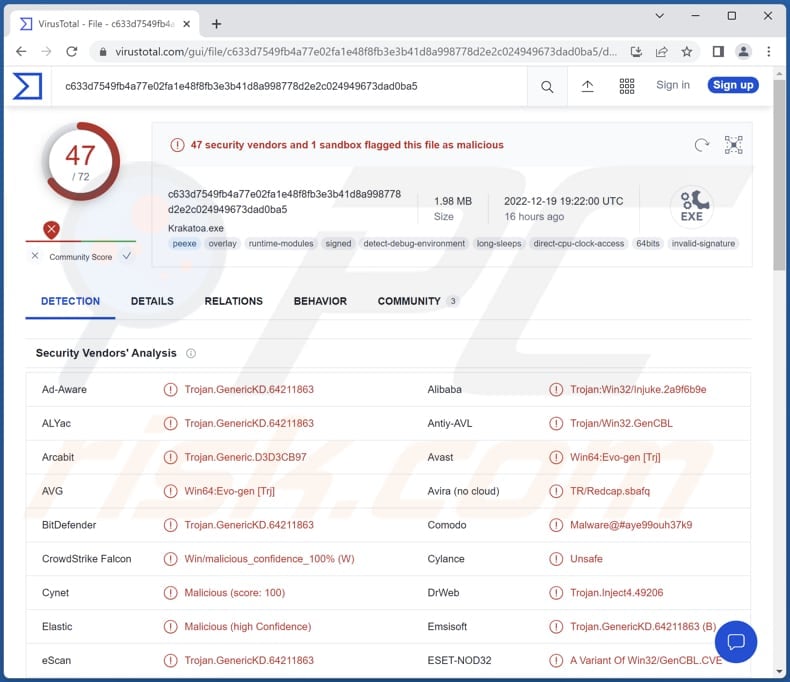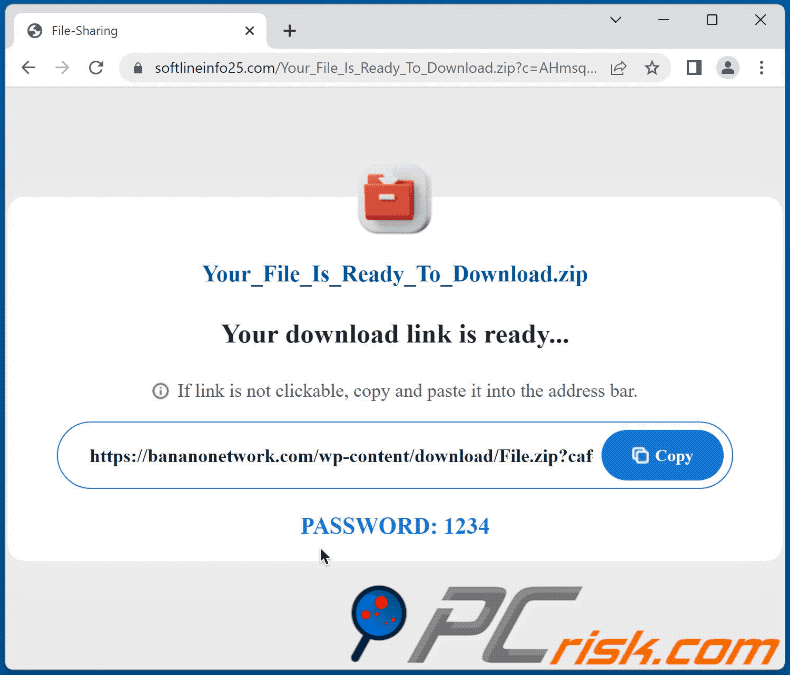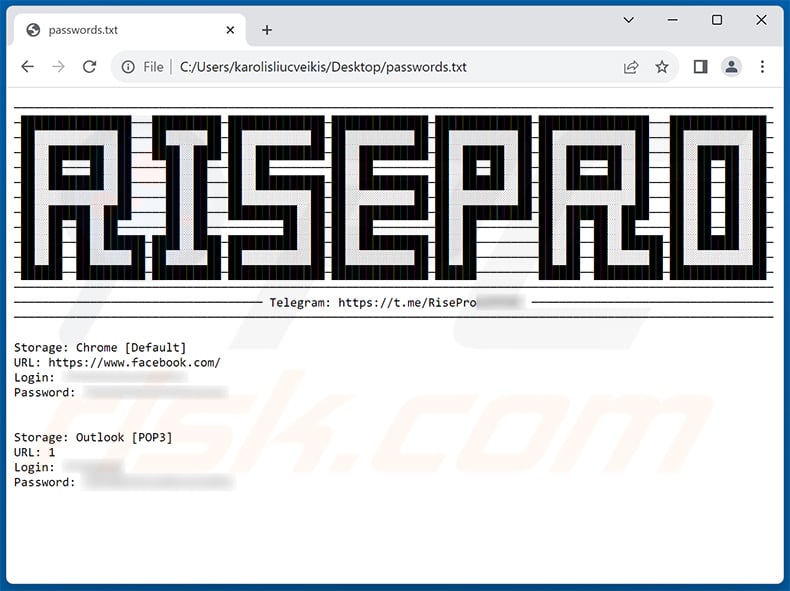How to remove RisePro stealer from the operating system
TrojanAlso Known As: RisePro information stealer
Get free scan and check if your device is infected.
Remove it nowTo use full-featured product, you have to purchase a license for Combo Cleaner. Seven days free trial available. Combo Cleaner is owned and operated by RCS LT, the parent company of PCRisk.com.
What kind of malware is RisePro?
RisePro is an information stealer that has similarities with another stealer called Vidar. It gathers sensitive data and extracts it in the form of logs. RisePro is written in the C++ programming language. Threat actors have been observed distributing RisePro via a malware downloader called PrivateLoader. The creators of RisePro are currently selling their malware via Telegram.

More about RisePro
Since RisePro shares many similarities with Vidar, there is a high chance that it can steal IP addresses, browsing history from multiple browsers (including Tor browsers), crypto wallets, messages from various messengers, and passwords. Also, RisePro may be capable of capturing screenshots.
It is known that RisePro steals data from the following web browsers: 7start, Amigo, Atom, BlackHaw, Brave, CatalinaGroup Citrio, CentBrowser, Chedot, ChomePlus, Chromium, Chromodo, Comodo, Coowon, CryptoTab, Elements, Firefox, Google Chrome, IceDragon, Iridium, K-Melon, Maxthon3, Netbox, Nichrome, Opera, Orbitum, Pale Moon, QIP Surf, Sputnik, Torch, Uran, Vivaldi, Yandex.
The list of targeted browser extensions includes Authenticator, BinanceChainWallet, BitAppWallet, Bolt X, CloverWallet, Coinbase, EQUALWallet, ForboleX, Guarda, GuildWallet, iWallet, Jaxx Liberty Extension, LiqualityWallet, Maiar DeFi Wallet, MathWallet, MetaMask, MewCx, NeoLine, NiftyWallet, Oxygen, PaliWallet, PaliWallet, Phantom, RoninWallet, SaturnWallet, TronLink, Wombat, XDEFI Wallet, and Yoroi.
The targeted cryptocurrency wallets are Anoncoin, BBQCoin, BBQCoin, Bitcoin, DashCore, devcoin, digitalcoin, Dogecoin, Florincoin, Franko, Freicoin, GoldCoin (GLD), Infinitecoin, IOCoin, Ixcoin, Litecoin, Megacoin, Mincoin, Namecoin, Primecoin, Reddcoin., Terracoin, YACoin, Zcash. Also, RisePro steals data from Authy Desktop, battle.net, and Discord apps.
Depending on the information extracted by RisePro, cybercriminals may use it to hijack online accounts, steal identities, make fraudulent purchases and transactions (including crypto transactions), etc. It is important to mention that stolen accounts may be used to deliver malware, scam other users, and other purposes.
It is known that data stolen with RisePro is exfiltrated in the form of logs. Those logs are uploaded to shadow markets and sold to third parties.
| Name | RisePro information stealer |
| Threat Type | Trojan, password-stealing virus |
| Detection Names | Avast (Win64:Evo-gen [Trj]), Combo Cleaner (Trojan.GenericKD.64211863), ESET-NOD32 (A Variant Of Win32/GenCBL.CVE), Kaspersky (Trojan.Win32.Injuke.ggme), Microsoft (Trojan:Win32/Tiggre!rfn), Full List (VirusTotal) |
| Symptoms | Information stealers are designed to stealthily infiltrate the victim's computer and remain silent, and thus no particular symptoms are clearly visible on an infected machine. |
| Distribution methods | PrivateLoader malware dropper, infected email attachments, malicious online advertisements, social engineering, software 'cracks'. |
| Damage | Stolen passwords and banking information, identity theft, the victim's computer added to a botnet. |
| Malware Removal (Windows) |
To eliminate possible malware infections, scan your computer with legitimate antivirus software. Our security researchers recommend using Combo Cleaner. Download Combo CleanerTo use full-featured product, you have to purchase a license for Combo Cleaner. 7 days free trial available. Combo Cleaner is owned and operated by RCS LT, the parent company of PCRisk.com. |
More about information-stealing malware
Typically, cybercriminals use information stealers to extract login credentials (e.g., usernames, IDs, passwords), credit card details, ID card information, social security numbers, and other sensitive information. Stealers can use different methods to gather data. One of the most popular ones is a keylogging method allowing stealers to record keyboard input (data typed with a keyboard).
More examples of information-stealing malware are PureLogs, Titan, and AcridRain.
How did RisePro infiltrate my computer?
The infection process begins with the victim downloading PrivateLoader malware. PrivateLoader functions as a dropper. It is used to distribute other malware. Cybercriminals use emails containing malicious links or attachments, pages hosting pirated/cracked software (or cracking tools), and similar ways to trick users into downloading and executing malware.
Fake software updating tools and files downloaded from P2P networks, third-party downloaders, free file hosting sites, etc., can cause computer infections too. Most threat actors use malicious MS Office, PDF documents, ISO files, archives (e.g., ZIP or RAR), executables, JavaScript files, and other files to distribute malware.
How to avoid installation of malware?
Always download software from official pages and legitimate stores. Do not trust other sources (examples are mentioned in the previous section). Double-check irrelevant emails sent from unknown, suspicious addresses. Do not open files or links in emails without being sure it is safe. Do not trust ads on shady web pages.
Keep the operating system and programs updated. Use a reputed antivirus software for computer protection. Scan a computer for threats regularly. If you believe that your computer is already infected, we recommend running a scan with Combo Cleaner Antivirus for Windows to automatically eliminate infiltrated malware.
Example of a website (which various scam and pirated/cracked software download sites redirect to) spreading RisePro stealer:

Screenshot of "passwords.txt" file used by cyber criminals to transfer victim's stolen data to their server:

Update March 26, 2024 – new technique has been observed in use to proliferate the RisePro stealer. This malware is actively spread via GitHub repositories. Thirteen currently known repositories share significant similarities; they primarily center on free software "cracks". Victims lured into downloading this content have to extract several password-protected archive files to get to the initial executable ("Installer_Mega_v0.7.4t.msi"; filename may vary).
Another thing of note is the anti-analysis measures taken by the cyber criminals. The MSI installer is bloated to a nearly 700 MB size and can crash certain reverse engineering tools. More information on these developments can be found in an article on the G Data blog.
Instant automatic malware removal:
Manual threat removal might be a lengthy and complicated process that requires advanced IT skills. Combo Cleaner is a professional automatic malware removal tool that is recommended to get rid of malware. Download it by clicking the button below:
DOWNLOAD Combo CleanerBy downloading any software listed on this website you agree to our Privacy Policy and Terms of Use. To use full-featured product, you have to purchase a license for Combo Cleaner. 7 days free trial available. Combo Cleaner is owned and operated by RCS LT, the parent company of PCRisk.com.
Quick menu:
- What is RisePro?
- STEP 1. Manual removal of RisePro malware.
- STEP 2. Check if your computer is clean.
How to remove malware manually?
Manual malware removal is a complicated task - usually it is best to allow antivirus or anti-malware programs to do this automatically. To remove this malware we recommend using Combo Cleaner Antivirus for Windows.
If you wish to remove malware manually, the first step is to identify the name of the malware that you are trying to remove. Here is an example of a suspicious program running on a user's computer:

If you checked the list of programs running on your computer, for example, using task manager, and identified a program that looks suspicious, you should continue with these steps:
 Download a program called Autoruns. This program shows auto-start applications, Registry, and file system locations:
Download a program called Autoruns. This program shows auto-start applications, Registry, and file system locations:

 Restart your computer into Safe Mode:
Restart your computer into Safe Mode:
Windows XP and Windows 7 users: Start your computer in Safe Mode. Click Start, click Shut Down, click Restart, click OK. During your computer start process, press the F8 key on your keyboard multiple times until you see the Windows Advanced Option menu, and then select Safe Mode with Networking from the list.

Video showing how to start Windows 7 in "Safe Mode with Networking":
Windows 8 users: Start Windows 8 is Safe Mode with Networking - Go to Windows 8 Start Screen, type Advanced, in the search results select Settings. Click Advanced startup options, in the opened "General PC Settings" window, select Advanced startup.
Click the "Restart now" button. Your computer will now restart into the "Advanced Startup options menu". Click the "Troubleshoot" button, and then click the "Advanced options" button. In the advanced option screen, click "Startup settings".
Click the "Restart" button. Your PC will restart into the Startup Settings screen. Press F5 to boot in Safe Mode with Networking.

Video showing how to start Windows 8 in "Safe Mode with Networking":
Windows 10 users: Click the Windows logo and select the Power icon. In the opened menu click "Restart" while holding "Shift" button on your keyboard. In the "choose an option" window click on the "Troubleshoot", next select "Advanced options".
In the advanced options menu select "Startup Settings" and click on the "Restart" button. In the following window you should click the "F5" button on your keyboard. This will restart your operating system in safe mode with networking.

Video showing how to start Windows 10 in "Safe Mode with Networking":
 Extract the downloaded archive and run the Autoruns.exe file.
Extract the downloaded archive and run the Autoruns.exe file.

 In the Autoruns application, click "Options" at the top and uncheck "Hide Empty Locations" and "Hide Windows Entries" options. After this procedure, click the "Refresh" icon.
In the Autoruns application, click "Options" at the top and uncheck "Hide Empty Locations" and "Hide Windows Entries" options. After this procedure, click the "Refresh" icon.

 Check the list provided by the Autoruns application and locate the malware file that you want to eliminate.
Check the list provided by the Autoruns application and locate the malware file that you want to eliminate.
You should write down its full path and name. Note that some malware hides process names under legitimate Windows process names. At this stage, it is very important to avoid removing system files. After you locate the suspicious program you wish to remove, right click your mouse over its name and choose "Delete".

After removing the malware through the Autoruns application (this ensures that the malware will not run automatically on the next system startup), you should search for the malware name on your computer. Be sure to enable hidden files and folders before proceeding. If you find the filename of the malware, be sure to remove it.

Reboot your computer in normal mode. Following these steps should remove any malware from your computer. Note that manual threat removal requires advanced computer skills. If you do not have these skills, leave malware removal to antivirus and anti-malware programs.
These steps might not work with advanced malware infections. As always it is best to prevent infection than try to remove malware later. To keep your computer safe, install the latest operating system updates and use antivirus software. To be sure your computer is free of malware infections, we recommend scanning it with Combo Cleaner Antivirus for Windows.
Frequently Asked Questions (FAQ)
My computer is infected with RisePro malware, should I format my storage device to get rid of it?
RisePro can be removed with antivirus software or manually (our removal guide is provided above). It is not necessary to format the storage device to eliminate RisePro.
What are the biggest issues that malware can cause?
The most common issues are monetary and data loss, additional computer infections, and identity theft. Also, cybercriminals can use malware to mine cryptocurrency, hijack online accounts, add computers to botnets, and more.
What is the purpose of RisePro malware?
RisePro appears to be a clone of Vidar stealer. Thus, RisePro may attempt to steal IP addresses, saved passwords, cryptocurrency wallets, browsing history, messages from messengers, and other data. Also, it may be capable of capturing screenshots. The purpose of RisePro is to steal information.
How did RisePro malware infiltrate my computer?
RisePro is distributed via a malware dropper called PrivateLoader. Typically, users infect computers via links or files received from threat actors via email, files downloaded from pages hosting pirated software (or cracking tools), P2P networks, free file hosting sites, etc. Threat actors use different techniques to trick users into infecting computers.
Will Combo Cleaner protect me from malware?
Yes, Combo Cleaner will remove malware. It can detect almost all known malware infections. In order to remove high-end malware, it is required to scan the operating system using a full scan. Usually, high-end malware hides deep in the system.
Share:

Tomas Meskauskas
Expert security researcher, professional malware analyst
I am passionate about computer security and technology. I have an experience of over 10 years working in various companies related to computer technical issue solving and Internet security. I have been working as an author and editor for pcrisk.com since 2010. Follow me on Twitter and LinkedIn to stay informed about the latest online security threats.
PCrisk security portal is brought by a company RCS LT.
Joined forces of security researchers help educate computer users about the latest online security threats. More information about the company RCS LT.
Our malware removal guides are free. However, if you want to support us you can send us a donation.
DonatePCrisk security portal is brought by a company RCS LT.
Joined forces of security researchers help educate computer users about the latest online security threats. More information about the company RCS LT.
Our malware removal guides are free. However, if you want to support us you can send us a donation.
Donate
▼ Show Discussion